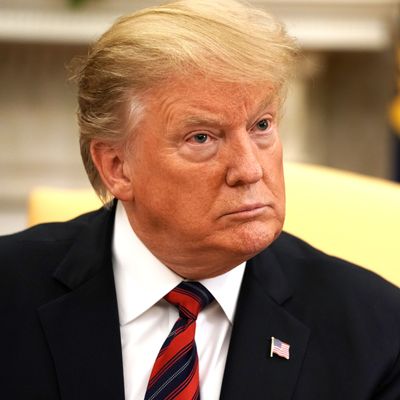
It’s not an exaggeration to say that at the elite and activist level Republicans hope — and Democrats fear — the recently robust economic trends will produce a second term for Donald Trump. Some observers just intone, “It’s the economy, stupid,” like a mantra; more sophisticated analysts deploy formulas in which major macroeconomic indicators like GDP growth and unemployment rates are combined with the president’s job-approval ratings and perhaps other data in predicting the 2020 presidential general election, absent any information about Trump’s Democratic opponent.
But such analysis depends on the assumption (generally valid in years past) that perceptions of the economy are mostly rational and don’t differ tremendously between people of different political persuasions. As the Cook Political Report’s Amy Walter notes this week, that’s one of many assumptions that seem no longer sustainable in the Trump era:
The Michigan Consumer Survey has done some fantastic work on exploring the issue of partisan differences in perceptions of the economy. Last September, the University of Michigan’s Richard Curtain found that partisan differences in perceptions of the economy are larger than at any time in recent history.
Not surprisingly, the study found that “Republicans held more favorable expectations during the Reagan, Bush, and Trump administrations, who were all Republican presidents. During the Obama administration, Democrats held more optimistic expectations.”
For example, during the Reagan administration, Republicans were on average, 11.5 points more optimistic about the economy, while Democrats were 7.4 points more pessimistic, for a gap of 18.9 points. That gap grew a bit during the George W. Bush and Obama eras; 20.9 to 23.9 respectively.
But, under Trump, that gap has turned into a chasm. The partisan gap now is 55.4 percent — twice as big as it was during Bush and Obama era and three times as big as it was during Reagan.
Specifically, Republicans were 31 percent more optimistic than average about the future of the economy and Democrats were 24.3 percent more pessimistic. Self-identified independents came right down in the middle, but I’m betting they, too, are split between Democratic and Republican leaners.
So people drawing from the same data (albeit in many cases through the lens of different media) and presumably a lot of the same real-life experiences nonetheless go in very different directions in what they expect to happen down the road. And that will almost certainly reinforce as well as reflect partisan differences.
These findings also provide a new perspective from which to answer the age-old but especially pertinent question about the extent to which voters are moved by economic concerns as opposed to cultural or partisan identity. Economic concerns currently appear to be shaped by identity, notes Walter:
[P]olitical scientists John Sides, Michael Tesler and Lynn Vavreck, in their book “Identity Crisis”…contend that issues of identity were more central to Trump’s victory than the issues of so-called economic anxiety. “Attitudes concerning race, ethnicity and religion were more strongly related to how Americans voted in 2016 than in recent elections. By contrast,” they write, “the apparent impact of economic anxiety was much smaller and not particularly distinctive compared to earlier elections.”
This also helps explain why those living in some of the swankiest zip codes are the most resistant to Trump-ism, while those even in areas that have been hit hard by Trump policies like tariffs, continue to support him.
Now it’s possible that this partisan divergence in perceptions could change if economic conditions continue to improve, particularly during the early election-year window in which such perceptions matter most in informing voting preferences. But if voters continue to diverge along partisan lines in how the expect the economy to evolve, they will likely continue to diverge in voting behavior as well. Again, this is a departure from past years in which people largely agreed on the direction of the economy, with the non-presidential-party finding other issues — even other economic issues, like the distribution of wealth and poverty in a thriving economy, or the affordability of medical care — to emphasize in trying to seize control of the White House.
To put it another way, the anger and mistrust that Trump has sown among members of the opposition party (and independents who lean in that direction) will sharply limit his ability to persuade these same people that the economy is in good shape and he deserves the credit. And even if things look good, the future will look dim to those who fear what Trump will do in a second term.
Now this also means that if the economy slows down or heads south, Trump will not bear the full brunt of disappointment; his partisans will still see prosperity around every corner. But barring something exceptional in a positive or negative economic direction, Trump’s going to have to campaign on his full record, his full agenda, and the full set of impressions he has made during his first term — while blasting away at his opponent as standing for a future ruined by socialism, secularism, and political correctness.
No matter how the economy performs, Trump is never going to be the sort of president who is primarily perceived by friends or foes as the safe steward of an improving status quo. So no, economic statistics alone won’t extend this presidency beyond 2021. If they could, his job-approval ratings would not be stuck in the 40s. At a minimum, he’ll need a dollop of cultural and racial resentment and a boatload of good luck in the opponent Democrats choose for him — and in again threading the needle in the Electoral College.






























